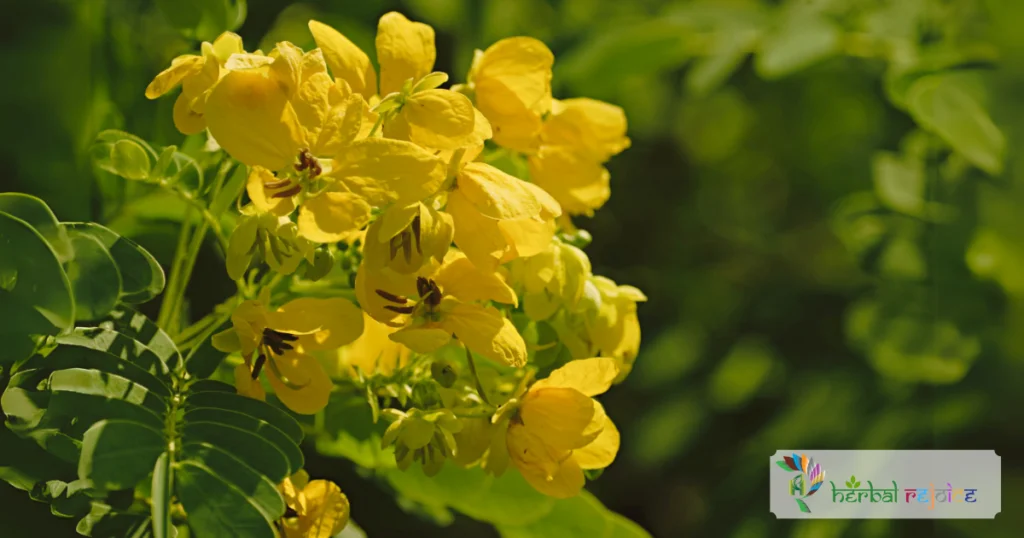Introduction to Senna
Cassia angustifolia Vahl., commonly known as Indian Senna or Tinnevelly Senna, is a powerful plant belonging to the Caesalpiniaceae family.
Senna is primarily used as a purgative to treat occasional constipation. It is also used to treat hiccups, fever, jaundice and amoebic dysentery.
This informative guide will delve into the English and scientific names, natural habitat, traditional uses, chemical composition, and potential health benefits of Cassia angustifolia.
By exploring its unique attributes, we can uncover the significance of this plant and its potential contributions to overall well-being.
Names and Habitat:
Cassia angustifolia Vahl., also known as Indian Senna or Tinnevelly Senna, was originally native to Sudan and Arabia. However, it is now mainly cultivated in districts of Tamil Nadu, with a smaller presence in Andhra Pradesh and certain parts of Karnataka.
Traditional Uses and Benefits Of Senna
Cassia angustifolia has a longstanding history of traditional usage and is valued for its diverse range of health benefits.
1. Purgative and Digestive Health:
Indian Senna is primarily used as a purgative, facilitating bowel movements.
It is employed in herbal compounds to treat conditions such as biliousness, stomach distention, vomiting, and hiccups.
Additionally, it has been used as a febrifuge and for conditions like splenic enlargements, jaundice, and amoebic dysentery.
However, it is contraindicated in inflammatory colon diseases.
2. Occasional Constipation:
The leaves and dried fruit of Cassia angustifolia are occasionally used to address constipation. They have been recognized for their stimulant laxative properties.
Chemical Composition and Key Components Of Senna
Cassia angustifolia contains various chemical compounds that contribute to its potential health benefits.
1. Anthraquinone Derivatives:
Cassia angustifolia contains anthraquinone derivatives, such as rhein and aloe-emodin.
These compounds contribute to the herb’s laxative effects and are primarily responsible for its purgative properties.
2. Flavonoids:
Indian Senna also contains flavonoids, such as kaempferol and isormamnetin, both in their free form and as glucosides. These compounds may contribute to the herb’s overall bioactivity.
3. Sennosides:
The active metabolite in the colon of Cassia angustifolia is rheinanthrone, derived from the sennosides present in the herb.
These compounds play a role in influencing the motility of the colon by inhibiting stationary contractions and stimulating propulsive contractions, resulting in the laxative effect.

Potential Health Benefits Of Senna
Cassia angustifolia exhibits promising potential for various health benefits.
1. Digestive Support:
The traditional use of Cassia angustifolia as a purgative and for addressing digestive issues suggests its potential benefits for supporting overall digestive health.
2. Constipation Relief:
The stimulant laxative properties of Cassia angustifolia make it a potential natural remedy for occasional constipation.
Safety Considerations:
While Cassia angustifolia offers potential health benefits, it is important to exercise caution and consider safety considerations.
It is advisable to consult for guidance on the appropriate use of Cassia angustifolia for therapeutic purposes. Additionally, it is important to adhere to recommended dosages.
Conclusion:
Cassia angustifolia Vahl., commonly known as Indian Senna or Tinnevelly Senna, holds significant potential for various health benefits.
Its traditional uses in promoting digestive health and relieving constipation highlight its importance in traditional medicine.
The presence of anthraquinone derivatives, flavonoids, and sennosides further emphasize its potential therapeutic applications.
By embracing the wisdom of traditional practices, Cassia angustifolia may provide a natural approach to support specific health concerns. As always, individual circumstances and safety considerations should be taken into account.
Frequently Asked Questions(FAQs)
What are the common names of Cassia angustifolia?
Cassia angustifolia is commonly known as Indian Senna or Tinnevelly Senna.
Where is Indian Senna primarily cultivated?
Indian Senna is primarily cultivated in districts of Tamil Nadu, such as Tirunelveli and Ramnathpuram. It is also grown on a smaller scale in Andhra Pradesh and certain parts of Karnataka.
What are the traditional uses of Indian Senna?
Indian Senna has been traditionally used as a purgative to facilitate bowel movements. It is also employed to treat conditions such as biliousness, stomach distention, vomiting, hiccups, fevers, splenic enlargements, jaundice, and amoebic dysentery.
Can Indian Senna be used for occasional constipation?
Yes, the leaves and dried fruit of Indian Senna have stimulant laxative properties and are occasionally used to address constipation.
What are the key chemical components of Cassia angustifolia?
Cassia angustifolia contains anthraquinone derivatives (such as rhein and aloe-emodin), flavonoids (kaempferol and isormamnetin), and sennosides.
How do anthraquinone derivatives contribute to the purgative properties of Indian Senna?
Anthraquinone derivatives in Indian Senna, such as rhein and aloe-emodin, are primarily responsible for its purgative properties.
What potential health benefits does Indian Senna offer?
Indian Senna may support overall digestive health and provide relief from occasional constipation.
Can Indian Senna be used for inflammatory colon diseases?
No, Indian Senna is contraindicated in inflammatory colon diseases.
Are there any safety considerations when using Indian Senna?
Yes, it is advisable to seek for guidance on the appropriate use of Indian Senna for therapeutic purposes. Recommended dosages should be followed.
Can pregnant or nursing women use Indian Senna?
Pregnant and nursing women should consult with healthcare professionals before using Indian Senna to ensure it is safe for their specific circumstances.
Can Indian Senna be used long-term?
The duration of use for Indian Senna should be determined based on individual circumstances.
Can Indian Senna cause any side effects?
While side effects are not specifically mentioned in the given text, it is advisable to monitor for any adverse reactions.
Can Indian Senna be used for children?
The use of Indian Senna in children should be approached with caution and under the guidance.
Are there any known allergies associated with Indian Senna?
Individuals with known allergies to plants in the Caesalpiniaceae family should exercise caution when using Indian Senna.
Can Indian Senna be used topically for skin conditions?
Indian Senna is primarily used orally as a purgative. Topical use should be approached with caution.
Does Indian Senna have any antioxidant properties?
The presence of flavonoids in Indian Senna suggests potential antioxidant activity.
Can Indian Senna be used as a weight loss aid?
Indian Senna’s use as a purgative may occasionally be associated with weight loss. However, consulting with healthcare professionals is advised for personalized guidance.
Can Indian Senna be used as a natural remedy for digestive discomfort?
Yes, the traditional use of Indian Senna for promoting digestive health suggests its potential as a natural remedy for digestive discomfort.
What is the appropriate dosage of Indian Senna?
The appropriate dosage of Indian Senna may vary depending on the individual and desired effect.


